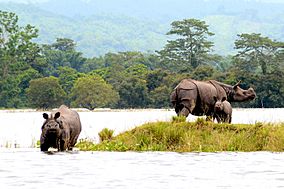Kaziranga National Park facts for kids
Quick facts for kids Kaziranga National Park |
|
|---|---|
| Kaziranga Rashtriya Udyaan | |
|
IUCN Category II (National Park)
|
|

Adult Indian rhinoceros with a calf at Kaziranga National Park
|
|
| Location | Golaghat and Nagaon, Assam |
| Nearest city | Golaghat, Nagaon |
| Area | 430 km2 (170 sq mi) |
| Established | 1908 |
| Governing body | Government of India, Government of Assam |
| World Heritage site | World Heritage Place by UNESCO since 1985 |
Kaziranga National Park is a very special national park in India. It is famous for being home to two-thirds of the world's great one-horned rhinoceroses. This means most of these amazing rhinos live here!
Kaziranga is also a World Heritage Site, recognized by UNESCO for its global importance. The government of India has named it a Tiger Reserve. This shows it's a key place for protecting tigers. It's also an Important Bird Area because so many different birds live here.
Besides rhinos and tigers, Kaziranga is home to many elephants, wild water buffalo, and swamp deer. One type of swamp deer can now only be found in this park.
Contents
History of Kaziranga Park
The idea to protect Kaziranga started in 1905. Mary Curzon, whose husband was the Viceroy of India, wanted to save the rhinoceroses. She saw how few were left and pushed for the area to be protected.
In 1908, Kaziranga became a "Reserve Forest." This was the first step to keeping its animals safe. Later, in 1916, it was called the "Kaziranga Game Sanctuary." Then, in 1950, its name changed to "Wild Life Sanctuary." These changes helped protect the park's amazing creatures even more.
Park Geography and Rivers
Kaziranga National Park is located in the Nagaon district and Golaghat district of Assam, India. It stretches about 40 kilometers (25 miles) long and 13 kilometers (8 miles) wide. That's a pretty big area!
Four main rivers flow through the park. These are the Brahmaputra, Diphlu, Mora Diphlu, and Mora Dhansiri. There are also many small lakes and ponds, called beels, scattered throughout the park.
The park is in the Brahmaputra floodplain. This means that when the river water gets high, parts of the park get covered in water. Flooding happens every year, and sometimes more than half the park goes underwater. In 2017, about 85% of the park was flooded. Sadly, over 100 animals died that year because of the floods.
To help the animals, there are higher areas in the park called chapories. These spots stay dry during floods and give animals a safe place to go. Many artificial chapories have been built with help from the Indian Army to keep the animals safe.
Kaziranga's Climate and Seasons
Kaziranga National Park has three main seasons: winter, summer, and monsoon.
The winter season is from November to February. It is usually mild and dry. During these months, the small water bodies in the park dry up. Short grass grows where the water used to be.
Summer is from March to May. It gets quite hot during these months. Animals often stay close to water sources to keep cool.
The rainy monsoon season lasts from June to September. This is when the park gets most of its rain. This heavy rain is what causes the yearly floods.
Amazing Animals of Kaziranga
Kaziranga National Park is home to 35 major types of mammals. Fifteen of these mammals have the highest level of protection in India.
The park is famous for its 'Big Five'. These are the One-Horned rhinoceros, Royal Bengal Tiger, Asian elephant, wild water buffalo, and swamp deer. Other large animals include gaur (a type of wild cattle), sloth bears, clouded leopards, and wild boar. Several types of deer also live here.
Smaller mammals include the rare hispid hare, mongooses, civets, pangolins, and badgers. The park also has several types of primates. These include macaques, lutungs, the Bengal slow loris, and the only ape found in India, the hoolock gibbon. The rivers in Kaziranga are home to the endangered Ganges dolphin.
More than 490 different kinds of birds live in Kaziranga. This includes 24 species that are globally threatened. The park is well-known for its large groups of nesting Spot-billed Pelicans and Adjutants.
Many types of waterfowl, like geese (including the rare lesser white-fronted goose) and ducks (like the ferruginous pochard and Baer's pochard), either breed here or pass through. Other rare river birds include kingfishers, herons, shanks, and terns. Birds of prey, called raptors, include the rare eastern imperial eagle, other eagles, and the lesser kestrel.
The park is also home to many reptiles. Two of the largest snakes in the world, the reticulated python and the rock python, are common here. You can also find the king cobra, Indian cobra, Russell's viper, and common krait. Fifteen different kinds of turtles live in Kaziranga. There are 42 species of fish, including the unusual ocellated pufferfish.
Plants and Trees of Kaziranga
Kaziranga National Park has four main types of plant life. These include alluvial inundated grasslands (grasslands that get flooded), alluvial savanna woodlands (grassy areas with scattered trees), tropical moist mixed deciduous forests, and tropical semi-evergreen forests.
Here's a breakdown of what covers the park:
- Tall grasses: 41%
- Short grasses: 11%
- Open jungle: 29%
- Swamps: 4%
- Rivers and water bodies: 8%
- Sand: 6%
Images for kids
-
One horned Indian rhinos grazing at swamp area near Bagori range under Kaziranga National Park in Nagaon district of Assam, India on Thursday. For years, rhinos have been widely slaughtered for their horn, a prized ingredient in traditional Asian medicines. Destruction of their habitat over the years has brought the rhinos to the brink of extinction. These animals are among the world's most endangered species.
-
An Indian roller at Kaziranga
-
Greater one-horned rhinoceros, mother and calf
See also
 In Spanish: Parque nacional de Kaziranga para niños
In Spanish: Parque nacional de Kaziranga para niños



















